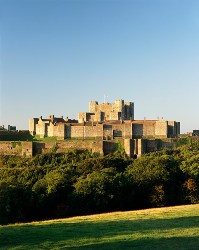For the past 12 years I have worked for English Heritage Education, the last 5 of these managing the offer to schools across the region at properties including Osborne House, Dover, Portchester, Carisbrooke and Deal Castles, Lullingstone Roman Villa and Battle Abbey & Battlefield. Often on the road on site visits, meeting potential partners or delivering training to site staff and teachers, I am lucky to have a lot of variety in my work. Here I give an example of a typical day in the office.
08:00 – 08:30hrs
Travel from home in Deal to the office; Dover Castle. I am extremely lucky, although most days are a bad hair day up here on the white cliffs. The Education Centre, which houses my office, also provides a great base for school groups visiting the castle, providing a range of resources to help make visits more engaging, including costumes and a collection of handling objects. I work here with Rachel Hudson, the SE Education Visits Officer, who manages the teams of volunteers and freelancers who deliver our taught sessions, or Discovery Visits, at key sites across the territory. The Discovery Visits enable students to really immerse themselves in an aspect of the story of a property and can be booked at the same time as a self-led visit.

08:30 – 09:00hrs
Check messages, post and deal with any urgent queries from our bookings team, based in Swindon, regarding special requests or other issues, so that they can get back to schools as quickly as possible. Teachers call 0870 333 0606 to make a booking to visit any of the manned EH properties across the country, or apply online. Permits and supporting notes are issued to teachers to help them plan activities for their students.
09:00 – 10:00hrs
Using our financial reporting and education booking databases, I compare actual visitors put through the tills with the number of school pupils booked in and chase up any discrepancies. Sometimes schools have to change their plans at the last minute, or travel problems can prevent them from visiting. I have to report on our performance against challenging targets, and we are aiming to welcome over 150,000 students to the SE properties this year. Dover Castle has received well over 60,000 so far. As the new National Curriculum comes into play, other properties, such as Battle Abbey & Battlefield will most likely see a rise in interest from schools, particularly Years 6 and 7 looking at History. Where sites or collections may no longer have obvious links with History, it will be crucial to develop resources which encourage schools to use them through study of Art or Literacy and extend our Arts Award offer, or look at other subjects, such as Science or Mathematics.
10:00 – 11:00hrs
Looking at our expenditure and income on taught sessions, I calculate our cost per head per student to ensure we are operating at a cost neutral or better position. When we started our programme of Discovery Visits (DVs), they were heavily subsidised. With the ever-increasing pressure on funding, we have reduced costs wherever possible, whilst ensuring the standard of the offer is maintained. It is also important to monitor the quality of the sessions through a variety of means, including teacher and student feedback. The new National Curriculum will be used to help us review our DV programme this summer, to ensure it can continue to satisfy customer demand.
11:00 – 12:.30
Liaise with the consultant commissioned to pull together the activity plan for our Fortress Dover Heritage Lottery Fund bid. We discuss the findings of a consultation carried out recently with teachers from local schools. It is vital that we develop the offer at our properties in response to customer needs and take an innovative approach to learning wherever possible. At Swiss Cottage and Museum, part of the Osborne Estate, we have focussed on the family audience and their wish to find out more about childhood at Osborne for the Royal children. Following consultation with families on the island, we have included a new play area and fort in our plans, plus new interpretation inside Swiss Cottage itself, to help visitors of all ages understand what it would have been like growing up at Osborne. This area will make the experience a lot more hands on than hands off.
12:30 – 13:00hrs
Leave the office to go to the venue of a Private View we are mounting in the town centre for one night only. The exhibition is being opened by the Mayor this evening, and we only have a short time frame to set it all up before the VIPs, students and families arrive. The artwork has been produced by students who have been working after school to develop their ideas on the theme of the ‘Consolation of Objects’. With the commemoration of the centenary of the First World War very much in our minds, we gave access to parts of collections from the Princess of Wales Royal Regimental Museum, based at Dover Castle, and the English Heritage SE Curatorial Store. Looking at memorabilia from many different conflicts, this small group focussed on the idea of keepsakes sent back from servicemen to their families, including their own. Inspired by what they saw, the students produced photographs, sketches and oil and mixed media paintings which tell a story of love and loss.
17:00 – 18:00hrs
After a lot of work, it is time to receive our honoured guests. It is great to see how the rolls of honour, postcards, letters, diary extracts, items of uniform and other objects, some made by the servicemen themselves, have really helped make learning compelling for these students. They have researched their own or other family histories, improved their understanding about the impact of conflict on society, and developed skills in their artistic practice which will improve their grades in exams.
20:00 – 21:00hrs
Taking down the exhibition after enjoying a fantastic evening opened by the Mayor, who gave a lovely speech about partnership between the cultural and heritage sector, the benefits to schools from learning outside the classroom and the effect of conflict on families. A long and demanding day, but one which really illustrates the transformational power of our work with schools through creative learning.
Back to top




